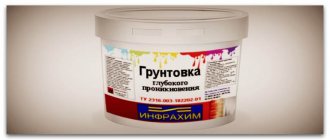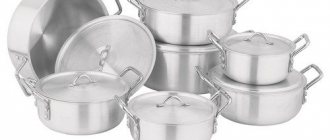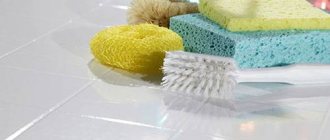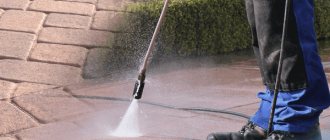The development of technology leads to the creation of new materials - innovative not only in appearance, but also in performance characteristics. These include cast marble. To care for such products at home, industrial marble products are used. But housewives successfully cope with some types of pollution using “folk” methods.
Artificial marble is made by mixing synthetic resins, mineral and artificial fillers. After hardening, the finished product is covered with a layer of gelcoat, and it acquires the properties of natural marble: hardness and beauty, with a characteristic shine. To avoid mistakes in care, it is necessary to take into account the properties of cast marble.
How can you clean marble floors?
We recommend using special
care products for marble floors, since other products can damage the surface of the material - damage the polishing, since they may contain weak and “non-weak” acids. If you don't have a special one at hand. means, it is better to use ordinary water, but the quality of the water can also damage the surface, for example, if white marble is washed with rusty water, then the surface can very soon absorb all the pollutants and turn yellow. Therefore, we recommend using only special ready-made cleaners and concentrates, but they must be diluted only with clean water (preferably the pH of the water is 6 - neutral). Below are products that have proven themselves to be effective for daily cleaning of marble floors, as well as for the most common household stains on such floors:
| Name | When to use |
| Cleaner LEM-3 1l Bellinzoni |
|
Cleaner Bravo Sgrassatore (alkaline) 1l Tenax |
|
| Stain remover MangiaMacchia Spot Remover 0.25l Bellinzoni |
|
| Rust remover MangiaRuggine 1l Bellinzoni |
|
Cleaning products for various stains
Depending on the type of contamination, various means are used to clean marble.
Advice
If you have doubts about the solvent used, consult the manufacturer’s website about the admissibility of its use or refuse to use it.
The following companies produce special products for cast marble:
- Vega;
- Akemi;
- MELLERUD;
Grease stains
Common stains left by dirty dishes or food debris can be washed off with a soft rag or sponge moistened with dishwashing detergent or regular soap. Then the surface of the product is washed with running water. After removing dirt, it is recommended to wipe the marble with a soft, dry cloth to remove stains and give the product shine.
Limescale
Limescale appears as white and yellowish spots on the surface of marble; its appearance is associated with the chemical composition of the water. Easy to clean using special or “old-fashioned” methods:
- cleaning products that are sold in any store and do not contain abrasives;
- food grade 9% vinegar applied to the surface for 2-3 minutes;
- lemon juice, which is applied with a soft cloth and washed after 1-2 minutes (this method, in addition to lime deposits, will eliminate unpleasant odors);
- mustard powder dissolved in water to form a paste (the composition will clean and disinfect the surface);
- ammonia diluted with water;
- the popular drink Coca-Cola, containing phosphoric acid.
Important!
Apply the compositions for no more than 2-3 minutes. After cleaning, the products are washed with plenty of clean water.
Rust stains
Brown-red deposits occur due to water leaking from taps containing an increased amount of iron.
You can clean rust:
- special chemicals;
- self-prepared solution.
The first option is the simplest, but the second won’t cause much trouble. 100 g of ammonia is poured into a glass jar, and 50 g of hydrogen peroxide is gradually and carefully added to it. The composition, heated to 35-40 oC, is applied to the rust with a soft cloth and after 10-15 minutes is washed off with clean water.
We recommend: Features of Desmokol glue and rules for its use
Dye
Oil, latex or acrylic paint that accidentally gets onto the surface of the product (for example, during repairs) can be removed using sunflower oil. There is no need to use solvents. After removing the contamination, the product is washed with soapy water.
How to protect a marble floor
To prevent stains from appearing on marble, it is necessary to use water repellents. But not every water repellent is suitable for this, since when applying such a coating it is important to maintain the vapor permeability of the material, because moisture stuck in the material will destroy the material with a temperature difference.
When choosing a water repellent, you need to decide whether you want the surface of the material to change its appearance or whether you want to preserve the natural color of the material.
If you choose the first option, in this case you need to use Proseal from Tenax; if you need to enhance the color (for example, when you have aged material and its color is not very saturated), then you need to use Ager from Tenax.
But even though we have protected the surface of the material, some contaminants can still push through the coating, but this will take time for them, so protect the material with the coatings listed above, and after stains appear, remove them immediately - then the surface Your marble floor will remain clean for a long time and will delight you.
Cleaning instructions
Work on cleaning cast marble from any contaminants is carried out according to the following algorithm.
- Moisten the surface of the product by wetting it with a sponge or spraying water from a spray bottle. It is important that the surface remains damp throughout cleaning - this will protect the marble from scratches.
- Apply liquid marble cleaner or foam to the surface. To do this, use a soft rag or sponge.
- After 1-2 minutes, wash off the dirt with clean water and wipe the surface with a dry cloth.
- Remove complex stains using the special methods described above, or by using household chemicals from the store.
- Use wax once a week to add shine to the surface. Wax compositions are used following the instructions for use.
How to polish marble floors
Over time, the polish of marble may become duller; this can occur due to mechanical damage (or natural mechanical wear) or due to improper care (we wrote about this above). In this case, to independently make the surface more attractive, you can use polish. For manual application, we recommend using lux line plus from Tenax; for mechanical application, you can use liquid and thick waxes, such as Sealux or Tewax.
How to Clean Dull Marble
Special polishes help restore tarnished marble floors. The photo shows how products based on natural wax provide marble with a stunning mirror shine. From a set of folk remedies, beeswax is best suited. It provides not only specularity, but also reliable protection from mechanical influences.
Sometimes an unforgotten old-fashioned method comes to the rescue - rubbing marble until it shines with turpentine. Despite the high-quality result, the restoration of the mirror effect is accompanied by a persistent smell of turpentine.
Still, the best remedy is a special paste or powder for cleaning the stone. Such products provide protection for marble floors from mechanical damage, ultraviolet radiation, water and other “enemies” of the natural material.
Marble floor cleaning
If, however, you failed to protect your surface, or you protected it, but left the stain for a long time and the pollutant managed to push through the protective impregnation. It is necessary to use special cleaners, to choose one or another cleaner, you need to understand why this or that stain appeared, the more accurately you find out what damaged the material, the more accurately the store consultant will be able to select a cleaner for you.
First, let's talk about what you shouldn't use to clean a marble floor. As mentioned earlier, household cleaners can contain weak and “strong” acids, which in turn can “burn” the polish. Therefore, if your surface is polished, you should absolutely not use them, so that you don’t have to resort to expensive polishing later. When working with marble, we usually use alkaline and neutral cleaners.
How not to clean marble
First, let’s list what absolutely cannot be used to clean the surface. The taboo list includes household chemicals containing abrasives and weak acids. The coating can be threatened by acidic liquids such as vinegar and wine. So the complete list looks like this:
- Household chemical cleaning products. Even weak acids can damage the fragile structure of marble, and abrasive powders will most likely leave behind circular scratches. It is also strongly recommended not to treat the material with ceramic tile cleaners.
- Dubious folk remedies like orange juice, cola. The drinks contain weak acids.
- Acidic liquids. Vinegar, wine and various juices with a high acid content can easily damage the surface of the stone. Therefore, it is advisable to remove ketchup stains and wine puddles immediately.
Household pollution
Marble does not withstand long-term exposure to coloring substances such as jam, coffee, red wine, ketchup, grass and leaves, puddles left by pets, traces of oil, etc.
These common substances that we come across every day are very harmful to marble floors. These substances can get clogged into microcracks and change the color and pattern of marble tiles.
Dust and dirt should be regularly removed from a marble floor, otherwise they will also clog microcracks and seams between the tiles. If you clean regularly, you can enjoy a beautiful, shiny and smooth floor for a long time without worrying about polishing.
Caring for marble fireplaces
According to their purpose, fireplaces are subject to cyclic temperature changes associated with heating and cooling. Over time, this can disrupt the structure of the marble and its external aesthetic appearance, which as a result acquires a spongy structure. This result is due to the weakening of the natural bonds between the marble crystals and is not always obvious, since outwardly the surface looks absolutely homogeneous. These defects primarily appear on the lintel and on the inside of the side walls of the fireplace. If this happens, the marble becomes even more vulnerable to dirt and liquids.
However, with proper care, cleaning and treating the surface of the fireplace with protective agents, inevitable defects may appear only after decades. You should also remember that as a result of invisible corrosion of fireplace tongs and grates in contact with the fireplace lining, rust spots may appear on it. To prevent this from happening, metal parts must be treated with an anti-corrosion compound and/or isolated from the surface of the fireplace.
Caring for granite products
Caring for granite involves removing sand and dirt from it, especially from smooth horizontal surfaces that you walk on. Any small debris can act as sandpaper, scratching your stone. Vacuum or dry mop floors, walls and steps. Wipe off dust from countertops with a clean, dry cloth. Wipe up spills immediately to avoid stains.
Caring for Granite Countertops
Granite countertops are the most practical and durable choice for the kitchen. Granite countertops are not afraid of acid and are less susceptible to physical damage and are difficult to scratch. In order for your countertop to remain in its original form, you need to remember the following: try to remove spilled liquids from the surface by blotting the same way as on any natural stone, and not by wiping it - and do this as soon as possible. Don't leave liquids on the countertop until the morning.
Most often, oil and acid (wine) stains remain on granite, so it is very important to remove them as soon as possible, after removal by treating the stone with a special PH-neutral cleaning agent. Impregnation of granite helps to reduce the density of the surface layer and reduce (up to 10 times) the absorbability of the surface. Therefore, as a protective measure, it is recommended to impregnate granite (soak it with a special composition).
When cleaning granite countertops in your kitchen and bathroom, first try simply wiping them with a soft velvet cloth or sponge soaked in warm water. Soak any food remaining on the surface first. This allows you to get rid of crumbs, dried sauces, traces of soup, tea, soap, etc. If not, add some acid-free dishwashing liquid to the water. Then rinse the surface thoroughly with clean water. Excess detergent can leave a film or whitish streaks on the granite. Do not use stronger cleaning products such as bath and tile cleaners or abrasive powders. They can leave stains and scratches on the stone.
Removing stains from granite surfaces.
The absorbed stain can be easily removed. Removing stubborn stains is a process that requires a lot of patience. In most cases, what you see is a solid sediment entrenched between the crystals, left after the evaporation of the liquid. The main task is to transfer it back into solution and wash it off. First of all, you need to determine whether the dirt dissolves in water or oil, i.e. stain left by tomato juice or salad dressing.
If the dirt can be dissolved in water, pour hot water (from the tap, not boiling water) over the stain and soak for several minutes. Then wipe off excess water. Cover the stain with a 5mm layer of paper towels and soak it in hot water. Place plastic wrap on top and a flat weight on top of it, like a cast iron frying pan or an encyclopedic dictionary. Leave all this for about 10 hours - preferably overnight, so as not to disturb anyone. Then simply throw away the towels along with the dirt that has soaked them. Let the affected area dry and take a closer look at it. If there is still something left from the stain, repeat the described procedure.
If the dirt is fat-soluble, do everything exactly the same, but use cold acetone instead of hot water. After 10 hours, throw away the paper towels and wash the problem area with clean water. If necessary, repeat the processing.
Polishing and crystallization of marble to restore the surface
Not always caring for marble on your own can give the expected result. When it comes to carrying out restoration work, namely polishing a marble floor and crystallizing it, you need to turn to the services of professionals. It uses special equipment and requires training and experience.
Request a call
You can always order marble care services from Legis Cleaning. We also offer regular maintenance of marble surfaces as part of comprehensive cleaning services in Moscow and the Moscow region. Call!.
How to remove plant stains
Oil or wax stains, as well as traces of soot, are best removed using anti-grease detergents. They contain an effective concentrate that easily removes dirt. If there is no chemicals, you can quickly remove oil stains by using blotting paper soaked in alcohol. It is enough to apply the product to the area, cover with a bag and wait for the contamination to be absorbed. Then wipe the floor dry.
What to remember
Natural stone is not difficult to care for, but requires attention to maintain its decorative qualities. To do this, it is often enough to maintain regular dry and wet cleaning. Additional polishing and protection increase the surface life. To prevent the tiles from becoming unusable, use only proven detergents that are suitable for the nature of the contamination. Wax remains the optimal polishing agent. It simultaneously protects the surface and also restores the natural appearance.
Ways to protect flooring
Several protection methods will help keep the stone shiny and beautiful.
Using wax
Wax creates a protective film that lasts a long time and preserves the expensive floor. However, there are also disadvantages - it requires periodic cleaning and updating of the layer.
Special dirt-repellent agents
Such compositions prevent various contaminants from penetrating deep into the marble, create a protective film, and make the floor easier to clean. Impregnation with dirt-repellent agents tints the floor, it shines and appears damp.
Combination of impregnation and wax
The combined method is considered the best. Mixed formulations are sold in stores and do not need to be prepared at home.
Polishing
Polishing protects the stone from abrasions and scratches. Special means are divided into several types:
- give the stone a matte shine without a mirror effect;
- products with a mirror shine;
- means that give the surface an anti-slip effect, and the floor becomes less traumatic.
Polishing restores dull floors.
How to prevent the formation of stains and prevent the destruction of marble?
If the marble floor is in the hallway, you should protect the surface and lay out a rug, otherwise street dirt and sand stuck to your shoes will definitely leave scratches.
You should not walk on natural stone floors in your home with shoes. The best way to preserve its original appearance is to walk on it barefoot, which, however, is not always possible.
A marble countertop is a stylish decorative element, but it gets dirty easily. Therefore, it is imperative to use cutting boards for cutting food.
Glass glasses must be placed on special stands, especially glasses with wine. Hot dishes should also not be placed on an unprotected stone countertop.
Only specialized products should be used for marble, and then at home, natural stone will retain its original appearance for a long time.
How do you like the article?
Removing tea, coffee and tobacco stains
Such stains leave pinkish marks on the marble. If the marble product is located on the street, then they can pass on their own, becoming lighter due to the sun's rays and being washed out by rain. But indoors, it is better to remove this type of pollution using special cleaning products. For this, a mixture prepared from a few drops of ammonia and a 20% solution of hydrogen peroxide is suitable. Soak a napkin in stain remover and leave it for a day. After this, rinse the marble with warm water, then wipe with impregnation and polish until shiny.
Caring for marble countertops
Marble countertops in the kitchen must be protected from exposure to hot objects. You should use coasters for hot dishes, as well as dishes and metal utensils that can scratch the surface.
Protect the marble surface of the countertop from exposure to prepared foods and especially juices, which contain a lot of acid - this causes the marble to become dull. This is why acid-containing products should not be used to remove stains and soap scum from marble products in the kitchen and bathroom. You can use a light solution of ammonia in water or special preparations.
What not to use to clean marble
Some substances are strictly not recommended for use on marble surfaces. Sand, chalk chips and other hard abrasive products are strictly not recommended for cleaning marble; they will leave scratches. Substances containing small amounts of acid will destroy the structure of the stone. Household detergents, salt, and vinegar are also not suitable for washing stone, as well as wine, cola, and orange juice.
Rags and brushes with a hard coating are also not suitable for stone. You should not use ammonia frequently. Wax should not be applied to white marble, as this will cause it to turn yellow. When using the vacuum cleaner, be careful not to scratch the stone with the nozzles.
Removing oil stains from lotions, oils, grease, cosmetics
Grease stains can leave dark marks on the surface of marble. If you notice such a stain, apply any absorbent powder, such as starch, to it as soon as possible. After some time, remove the powder and apply a new one. Do this several times. Leave the last portion of starch for 24 hours, and then remove it using any detergent for marble surfaces (alternatively, you can use an aqueous solution of ammonia). Wipe the marble dry, treat with impregnation and polish.
If the stain is not removed, use a solvent. Soak a napkin (several napkins) in acetone, open the windows and leave them on the stain. Do not keep the mixture for too long to avoid poisoning, as acetone vapors are poisonous, and do not use acetone near heating appliances and gas stoves.
Recommended professional products
There are several products that are more effective when cleaning marble flooring:
- Stone Tech;
- Melon ZhS 9;
- Fila Marble (Clener, PS 87);
- resolve;
- Sanet Sprinter;
- Kiilto Clean;
- Lavosan;
- Simple Green;
- Restorer.











